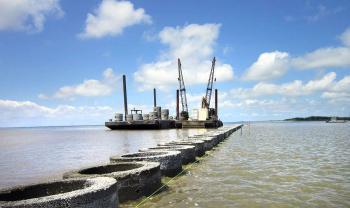ARTIFICIAL REEFS AIMED AT CREATING ‘LIVING SHORELINE’
An innovatively designed artificial oyster reef system manufactured in St. Mary Parish is designed to create a living shoreline and may soon help protect the parish’s coastline, the engineer who created the product says.
OysterKrete is a type of porous concrete made specifically for growing oysters in order to help restore the coastline. Tyler Ortego of ORA Estuaries created the product as part of a student project while he was an engineering student at LSU. OysterBreak is the proprietary design modeled after the Olympic rings.
Ortego helps Wayfarer Environmental Technologies engineer and sell OysterBreak and OysterKrete products.
Oldcastle Precast, which has an operation in Franklin, manufactures the OysterKrete product.
“The idea is we’re creating scaffolding, and the oysters are taking over over time,” Ortego said.
Michael Turley, owner of Wayfarer Environmental Technologies, has the exclusive license to the OysterBreak and OysterKrete technology after having bought the rights from Ortego.
Wayfarer has bid on a restoration project south of Bayou Sale and west of the Wax Lake Outlet in St. Mary Parish at Point Chevrueill, Turley said. “Our primary competitor is rock,” Turley said. Rock dikes are widely used for coastal restoration projects as opposed to using concrete, he said. The contract for the project is scheduled to be awarded Thursday, Turley said.
The concrete structures at Point Chevrueill would not be OysterKrete because the salinity is not high enough to grow oysters, Robicheaux said.
However, using regular concrete instead of OysterKrete is much less expensive, Turley said.
Ortego said, “There are some oyster reef projects in the CPRA (Coastal Protection and Restoration Authority) master plan that go from Marsh Island and connect to St. Mary Parish. Those I think we might be able to grow oysters.”
The concrete rings can be spaced about six inches apart to give more linear footage along the coastline without spending any extra money, Turley said. Sediment can build around the structure over time, he said. OysterKrete consists of “gluing rocks together,” Ortego said.
Dale Robicheaux, sales manager for Oldcastle Precast, said no dredging is needed to install OysterBreak structures as there is with rock structures.
Ortego recently won the New Orleans Entrepreneur Week Water Challenge, a business plan competition related to drinking water, wastewater, storm water management and coastal restoration. Ortego was the lone coastal restoration entry and the prize was $50,000, legal services and a year of office space, he said.
“Our design and structure is based on a true living shoreline. That’s the difference between us and most of our competitors,” Turley said. The structure’s design creates an environment for shellfish with the primary goal being shoreline protection, Turley said. “You get all those additional values just from one structure, and you don’t get any of that with rock.”
Rock structures sink because of its weight while OysterBreak structures weigh 24 percent to 31 percent less than a rock profile, Turley said.
Oysters have a better survivability rate due to the crevices in the OysterKrete, Turley said.
“It’s an opportunity for governments at the local level to save huge amounts of money because we spend a lot of money on marsh creation where we pump it in to make islands and marshes,” Turley said. “In this case you’re getting all you’re pumping for free.” The structure causes the sediment to fall out of the water naturally, Turley said.
One of the company’s first projects on the Louisiana coast was for the Paul J. Rainey Refuge at Vermilion Bay in 2010, Turley said. That project was immediately followed by another project in the same area, both of which were done in conjunction with the National Audubon Society, he said.
OysterKrete is a skeleton for oysters to build on and relies on Mother Nature to do the work, Robicheaux said.
Turley said, “As the oysters grow, and they get bigger, that just means the structure has greater potential to resist waves.”
Robicheaux said throughout a roughly 50-year period oyster reefs have been dug up all along the Gulf Coast. Those oyster reefs used to protect the coast from storm surges and floods, he said.
Turley grew up in Maryland near the Chesapeake Bay, which used to have lots of oyster but now barely has any left due to harvesting, he said. “That’s really why I came down here is because I didn’t want to see what happened there be reproduced down here,” Turley said.
Wayfarer is on its sixth coastal restoration project on the Louisiana coastline, Turley said. The costs of its projects have decreased drastically since its first project in Louisiana. “When we first started, we were well into almost $725 to $735 a foot,” Turley said. Costs have dropped to $375 per foot of OysterKrete at its Tiger Point project, he said.
Turley said his company’s coastal restoration products are not the cure to solving all coastal erosion. But, “We are a good tool in a tool box,” Turley said.
By Zachary Fitzgerald zfitzgerald@daily-review.com
- Log in to post comments

